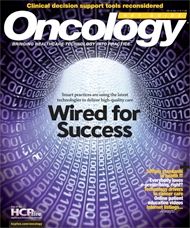Publication
Article
ONCNG Oncology
Oncology Outlook: Setting Standards in Healthcare IT
Author(s):
The decision makers in your organization who are tasked with translating strategic directives into the tactical principles and processes that will guide the creation of your IT architecture must make many ground-level choices that will have profound long-term effects.
The decision makers in your organization who are tasked with translating strategic directives into the tactical principles and processes that will guide the creation of your IT architecture must make many ground-level choices that will have profound long-term effects. However, nearly every decision they make will be influenced by organizational and industry-level data and technical standards.
Decisions affected by standards can involve things as simple as which operating system your staff should be using—should you keep running Windows XP or migrate to Windows Vista? Are the software tools you are currently using capable of running on Vista? Is it better to hold off and wait for the release of Windows 7? Is it better to purchase “best of breed” applications that might meet some of the practice’s unique needs and then figure out how to connect them, or buy comparatively generic systems that are more integrated but perhaps have less developed vertical space?
Decisions made when setting organizational data standards and putting into place the processes that guide data capture and archiving represent a unique opportunity to capture information as a byproduct of workflow. However, because clinical data lose their value over time, the organization must decide which data it most wants to capture and for how long the data should be retained. Is a mammogram image scanned from four years ago still needed for immediate access today? How will your organization separate the main data system, which holds immediate critical data, from the storage and archiving systems?
This is also the opportunity to be forward looking and try to anticipate changes that may affect the industry in the near future. How will information from genetic testing and recurrence risk tools and other decision support tools be captured and integrated into decision making? How will information about high-risk breast cancer patient populations be handled and tracked?
On a larger scale, there are constantly evolving industry-wide data and technical standards that affect how disparate software products and systems transmit and share data. Standards are the foundation for interoperability; when well-defined standards are in place, information can be shared among providers, payers, and other groups, even if it originates from different computer systems. Standards can enhance patient safety, promote quality improvement, and facilitate data mining and evaluation. Standards can also reduce the cost of implementing and maintaining systems and can maximize the return on investment by optimizing the utility of the various tools.
There are several groups and organizations responsible for developing and enacting data standards. The American National Standards Institute (ANSI) is a private nonprofit organization that oversees the development of voluntary consensus standards for products, services, processes, systems, and personnel in the United States.
Health Level Seven (HL7) is an international, all-volunteer organization of healthcare experts and information scientists involved in the development of international healthcare standards. The name “Health Level-7” is a reference to an Open Systems Interconnection (OSI) reference model with seven layers: (1) physical, (2) data link, (3) network, (4) transport, (5) session, (6) presentation, and (7) application layer. HL7 is also a term used to refer to some of the specific standards created by the organization. HL7 and its members provide a framework (and related standards) for the exchange, integration, management, sharing, and retrieval of electronic health information.
Digital Imaging and Communications in Medicine (DICOM) is a standard for handling, storing, printing, and transmitting information in medical imaging. It includes a file format definition and a network communication protocol. DICOM enables the integration of scanners, servers, workstations, printers, and network hardware from multiple manufacturers into a Picture Archiving and Communication System (PACS).
If we want to be able to register a new breast cancer patient, fill out HIPAA forms, document the clinical visit, look at her mammograms and CT scans, review lab results, schedule a follow-up visit, bill and collect for the services, and share the information with providers at other sites, and do it all in a paperless environment, every one of these standards will be involved. Beware the small vendor that tries to sell you on its homegrown tool that does not adhere to these standards. Your data could end up in a locked box, impossible to share with other providers and healthcare stakeholders.
Dr. Sharma is CEO of Texas Cancer Associates, a midsize oncology practice based in Dallas/Fort Worth, TX. He is also CEO of HealthIT, an Internet services company that supports the patient/ provider network with technology solutions, and founder of NextGen Oncology, which works to provide next-generation solutions for the diagnosis, management, and treatment of cancer. E-mail Dr. Sharma at JSharma@MyCancerCenter.com.
